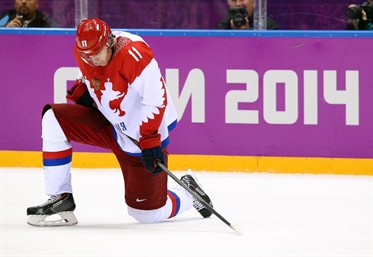Where it all went wrong
Where it all went wrong
Reasons behind Russia’s slump in Sochi

 Yevgeni Malkin is devastated after Russia's quarter-final loss to Finland. Photo: Andre Ringuette / HHOF-IIHF Images
Yevgeni Malkin is devastated after Russia's quarter-final loss to Finland. Photo: Andre Ringuette / HHOF-IIHF Images
And yet, for the second Olympics running, the Big Red Machine stalled at the Quarter-Final stage. So, what went wrong?
Struggling stars
Big occasions call for big performances from big players. Something like the way Yevgeni Malkin tore up Helsinki in 2012 as Russia won the Worlds with a perfect 10 victories. Instead Russia’s top guns largely misfired. Ovechkin opened up with a goal on his first shift, but that zinger against Slovenia was the start and end of his tournament. His return of one goal from 24 shots wasn’t the only glaring failure; Malkin and Kovalchuk yielded just three points each in five games, while only Datsyuk and Radulov really led by example in scoring as they posted six points each. For a team built around devastating firepower, this just wasn’t good enough.
Coaching calls
Zinetula Bilyaletdinov’s record as a coach commands great respect, and few quibbled his appointment after the disappointment of the 2011 IIHF Ice Hockey World Championships. But a coach who knows his own mind and enforces it with iron can be a mixed blessing. The Russian national team only knew one way to approach games, and there rarely seemed to be evidence of a Plan B.
For example, with Malkin and Ovechkin struggling for results, why not swap around that line? Or, chasing a two-goal deficit deep in the third period against Finland, why persist with a long bench? After the Finland game, and facing a barrage media questions, Bilyaletdinov spoke in general terms of his responsibilities but declined to go into specifics in the immediate aftermath of defeat. But the issues will not go away quickly, even with a successful World Championship campaign to follow it up.
Continue readingUnder pressure
Playing at home, according to Russian tradition, means that ‘even the walls help’. But familiarity is one thing; bearing the weight of a nation’s expectations is quite another. Sochi’s crowds were sold the idea that this would be Russia’s golden hockey moment, and when the product failed to match the advertising they quickly lapsed into a sullen silence. Elsewhere, the fol-de-rol around the Games, up to and including presidential visits, placed the Russian team in a goldfish bowl, which did little to ease the team’s preparations for the tournament.
Team work
The first period against Norway, and almost the whole game against Slovakia illustrated the problem: limited but well-drilled opponents make it tough for Russia to play, and those individual stars attempt to win games single-handedly by pulling off Hollywood plays and burying highlight reel goals. Sure, when it works it’s great – think Kovi in 2008, or Bure in 1998. But when it fails, teams need to fall back on simple, basics. Tighten up the neutral ice, dictate possession of the puck and look for easy outlets. That’s the platform that enables stars to shine. Norway and Slovakia built the platform, but lacked the star quality. Finland added finishing power, and ended Russia’s hopes. Teamwork 1, Individualism 0.
Enemies at the gates
Finland lined up against Russia with eight players from the KHL, Russia’s leading club competition. In addition, goal scorer Juhamatti Aaltonen also spent time there finessing his finishing skills before moving back to the West. Previously those guys would likely have plied their trade in other, weaker European leagues, or hacked around the AHL circuit hoping for a shot at the big time.
The KHL has raised the standard of European hockey, especially among those who aren’t quite up to the demands of the NHL. It’s a great competition, but while it makes Russian clubs stronger it also serves as a handy training ground for Europe’s emerging talent. That’s what enabled Finland to turn to Jarkko Immonen with relative confidence as their centres dropped out with injuries – it adds depth to the rosters of Russia’s Euro-rivals, without yet slowing the drain of top talent across the Atlantic.
Concentration
The signs were ominous in game one. After racing into a two-goal lead and betraying no sign of first-night nerves, it seemed that Russia was on course to batter Slovenia and throw down a marker for the tournament. By the end of the second period it was 3-2, there were question marks over the defence, and Slovenia was on a high. Several players admitted after the game that the attitude wasn’t right at times in that encounter, but there was little evidence of lessons being learned in lackadaisical first-period showings against the Norwegians and Slovakians. Playing the U.S. is an easy source of motivation; great teams dispatch the also-rans with greater finesse.
Lady luck
Even the best teams enjoy a kindly bounce at times, and that never really went Russia’s way. It wasn’t just the USA game and the disallowed goal which cost the hosts a potential win. While the decision was correct according to the rules, it was still a rough break to lose a goal in circumstances outside of the team’s control, and that defeat ultimately pushed Russia on to a challenging path through the tournament.
Similarly, the shot from Yevgeni Medvedev which Alexander Syomin deflected past the stranded Jan Laco and on to bar and post could easily have earned a valuable regulation win over Slovakia, avoiding the qualification round and lining up a weaker quarter-final opponent. Small margins sometimes make a huge difference, but winning teams have a habit of ‘making their own luck’ or at least overcoming adversity more readily.
Back to Overview











































